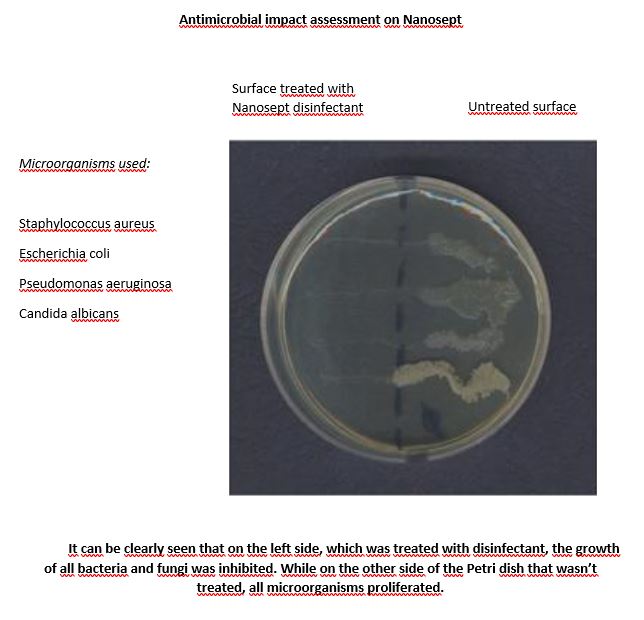ANTIBACTERIAL EFFECT OF NANOSEPT®
Application concentration, exposure time
For concentrate:
- Bactericide (also MRSA) and fungicid effect: 1-3 minutes
- Antiviral effect: min. 30 minutes
- Spore killing effect: 30 minutes
- Tuberculosis killing effect: 60 minutes
In the diluted state:
- Bactericide (MRSA) effect:
- 25% aqueous solution: 5-10 minutes, depending on the impurity
- Fungicidal effect:
- 25% aqueous solution: 30 minutes
- 50% aqueous solution: 10 minutes
- Antiviral effect:
- 25% aqueous solution: 60 minutes
- 50% aqueous solution: 40 minutes
Procedure for antimicrobial impact studies
1. Standard antimicrobial impact study (IMSL – JIS Z 2801: 2000):
Two microorganisms are used in the standard, Escherichia coli Gram and Staphylococcus aureus Gram + bacteria. During the procedure, bacterial suspensions containing 2.5 x 10 5 to 1.0 x 10 6 cells per ml are applied to the surface to be examined and left on for 24 hours at 35 ° C. After the time has elapsed, the microorganisms are removed from the test sample and inoculated onto the medium. If bacteria form colonies, they are counted. This procedure is also performed with a “blind” sample and the colony numbers obtained are compared.
2. Antimicrobial impact study of NANOSEPT® disinfectant:
The sample was prepared by treating one half of the surface of the Petri dish with Nanosept® disinfectant while leaving the other half untreated. After the disinfectant dries on the Petri dish, it is subjected to an antimicrobial effect test.
The procedure starts with laying cca 8 ml of substratum at 42 °C on the disinfectant so that it should be 2-3 mm thick and then inoculate the 4 microorganisms on this solid medium layer.
The concentration of the microorganism suspension used is 105-106 cells/ml.
Incubation takes place at 30°C for 24 hours
If the sample has an inhibitory effect on the growth of microorganisms, they do not grow on the medium, if not, they form colonies.
This procedure is visual, no colonies are counted here, and the untreated surface of the Petri dish is compared to the surface treated with Nanosept® disinfectant.
Bacteria used:
- Staphylococcus aureus (Gram +)
- Escherichia coli (Gram-)
- Pseudomonas aeruginosa (Gram-)
Fungi used:
- Candida albicans (Yeast)
